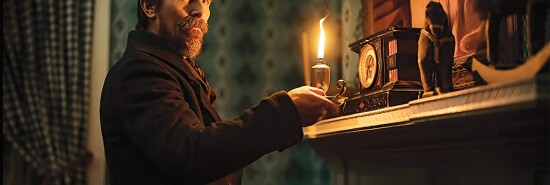
Christian Bale’s gothic provocation
Graham Hillard
As is now typical, The Pale Blue Eye arrived on Netflix last Friday after a blink-and-you’ll-miss-it theatrical run. Though that business model is destroying the moviegoing experience and will likely put whole cinema chains out of business in the next few years, I didn’t mind it in this case. The latest collaboration between actor Christian Bale and filmmaker Scott Cooper is slow, spooky, and strange as hell. This is a movie to be watched at home, under a blanket, among familiar things.
Based on the 2003 novel by Louis Bayard, The Pale Blue Eye is at once a detective yarn and a literary origin story. Bale plays Augustus Landor, a veteran sleuth called in to solve a grizzly crime at the U.S. Military Academy. Despite the year (1830) and the weather (brutally cold), the West Point in which we find ourselves is a genteel place where careful manners reign. That a murdered cadet has been posthumously relieved of his heart is, in the eyes of the school’s administrators, a simply intolerable state of affairs.
Determined to aid Landor’s investigation is one Edgar Allan Poe (Harry Melling), an academy student of such overwhelming oddity that one is inclined to demand his own alibi on the night in question. Abuzz with bookish intuitions, Poe deduces at once that the killer must be a poet. (“To remove a man’s heart is to traffic in symbol.”) Later, handling a scrap of paper found clutched in the victim’s hand, he makes an observation that blows the case wide open. Where Landor is taciturn and professional, Poe is a whirling dervish of raw inquisitive talent. Like innumerable detective films before it, Cooper’s picture is as concerned with the interplay of these discordant personalities as it is with the crime that brought them together in the first place.
Indeed, one could do worse, assessing The Pale Blue Eye’s qualities, than to look at the performances of its two leads. As Landor, Bale is almost unsettlingly bland, as if determined to shield his character’s inner life from scrutiny. Melling’s Poe, meanwhile, is a nervous crackpot with the accent and timbre of a tent revivalist. Peering out through his distractingly close-set eyes, Melling captures the future writer’s intentness even as he errs too often on the side of theatricality. A straight-on shot of him watching a young woman play the piano may well be the weirdest image to appear on screens this year.
Cooper’s previous films with Bale have been far rowdier affairs, emphasizing the actor’s caged ferocity rather than his decorum. In Out of the Furnace (2013), Bale fairly seethed as a vengeful brother caught up in the world of backwoods gangs. Hostiles (2017), meanwhile, imagined the leading man as an Indian-hater roaming Comanche territory a quarter-century after the Civil War. What The Pale Blue Eye has in common with these pictures is its love of genre conventions for their own sake. Cooper’s latest begins with a telltale heart, an obvious allusion to its most famous character’s eventual creation. It goes on to encompass black magic, sickly young women, burning mansions, and enough gothic tropes to satisfy even the greediest devotee to the macabre.
Joining Bale and Melling in delivering this haul is a collection of notable supporting talent. As the academy’s weather-beaten house physician, the English actor Toby Jones (Dobby in the Harry Potter films) is characteristically eccentric and excellent. Also strong are Harry Lawtey (HBO’s Industry) and Lucy Boynton (Bohemian Rhapsody) as the doctor’s children, who have their own roles to play in the unfolding drama. Best of all is the 92-year-old Robert Duvall as a scene-stealing expert in the occult. Yes, the production gets campier as it goes, but these are real actors doing thoughtful work. Were it not for the movie’s disastrously bad final act, I would have recommended it wholeheartedly as an odd but effective chamber ensemble.
Alas, The Pale Blue Eye is unable to escape that most tiresome of storytelling devices, the “reveal.” While some narrative twists ennoble what has gone before, lending the audience a welcome new perspective, others render all previous action beside the point. If another Bale film, The Prestige (2006), is among contemporary cinema’s best examples of the former, The Pale Blue Eye falls squarely in the latter category, an exercise in disorientation that leaves one barely interested in toting up the continuity problems. Some viewers will likely see the surprise coming, especially upon noticing that half an hour remains after the crime’s seeming solution. I was perplexed, then annoyed, then indifferent. Surely this is not how Bayard concluded his acclaimed and much-read novel.
It is, of course. And whether the reversal works on the page, I will leave for others to decide. On the screen, however, it is an epic misstep, a cheap “gotcha” unworthy of sustained attention. Might I suggest responding to the error by watching only the film’s first hour and 40 minutes? The story thus produced is entirely complete. More than that: It’s satisfying.
Graham Hillard is the author of Wolf Intervals (Poiema Poetry Series) and a Washington Examiner magazine contributing writer.
